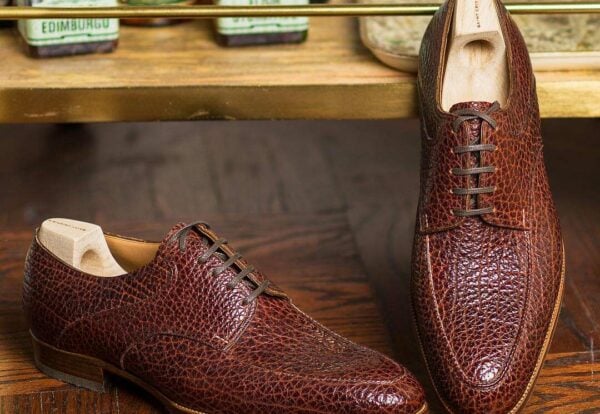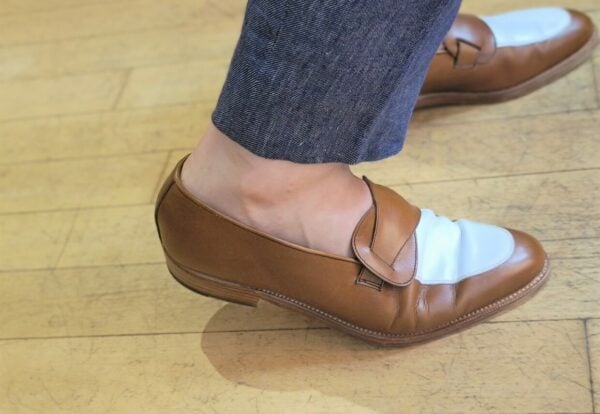
I have fit/measured thousands and thousands of people in my life looking to buy dress shoes. And in doing so discovered a lot about fit, the idea of it, how it differs from one culture to the next and how the Brannock Device is not what it’s cracked out to be. So here is my take as to why and how we should start using it solely as a guideline (or starting point), and nothing more.
You see, feet are actually a complex part of the body. There are so many components that make up the feet and their measurements. You have length, you have width, the inside arch, the outside arch, instep height, ankle height, toe thickness, heel girth, and the list goes on. And all of these factors affect fit. And what does a Brannock Device tell you? Two of them; Length and width. And supposedly inside arch length (although I am not sure if I ever believed that measurement as I measured at like arch size 11 since my feet are semi-flat and long and narrow. But even a US9 shoe, if anything, kills my arch from the over-working. Imagine a US11 shoe! I would pop right out of that thing. And I would know. When I was young and dumb, I wore larger-sized shoes to ‘have larger feet.’ Big mistake. Lots of pain in my feet when I was younger. Don’t make that same foolish error.
Even the width I found to be somewhat misleading. I measured guys at 3E and fit them into a pair and they were swimming in them. Measured guys at E and they fit just fine into ‘D’ width shoes. And alternatively measured guys at E and they needed 3E due to the girth of the foot (from depth i.e. chunky from top to bottom).
And while the Brannock Device is the theme of this post, it is not the only culprit as a shoe brand’s idea of a US9 or a ‘D width’ can also differ. That is why getting it stuck into your head that you are a US9D is an error from the get-go. Because, yes, maybe in Nike’s you are US9D. But in Allen Edmonds, you are US8.5, in Santoni, US8, and in Paul Parkman, a EU40.5 (US7.5). And therefore your Brannock measurement is really only telling you a theory. Not a fact.
And that does not even touch on cultural preferences of fit. Many French do not want one molecule of free air in their shoes while most Americans want their dress shoes to fit like running shoes: loose and comfortable. I once assisted a gentleman from Northern Europe, one of the Nordic countries, and he told me he was 42 (aka US9). I measured his length at US11.5. Sure enough, I brought every pair of shoes from US11.5 until we reached US9. Guess what he purchased? The US9. I was flabbergasted. And instantly learned something that day.
And not to mention how many American guys I would measure at smaller sizes and they wanted at least 1 size larger for their Ego-Boost. All the while slopping around in their shoes looking foolish. And yet in other countries, like the Dominican Republic, I see these big guys wearing tiny shoes, at least 1-2 sizes smaller. I can literally see their toes nearly busting out of the fronts. But for them, that fit feels good. And who is to tell them they are wrong? The Brannock would give them a different story than what they like.
My message here is do not hold your faith in the Brannock measurement. Use it as a starting point. But do not hold the line at its length measurement. It’s okay to have smaller feet than you thought. It’s okay for you to be 3 different sizes in 3 different brands. The best thing you can do when looking to jump into a new brand is research how their brand fits compared to other like brands. That research will give you better advice than jumping into the fire of online shopping with just a Brannock Measurement.














One of the most informative posts I’ve ever read about shoe fit, some of the many variables and the differences by maker and culture. Makes me feel better about having shoes that run from euro 40 to 42.5 and US 7-8.5
Glad that you enjoyed it Jim! Thanks for sharing
Not all footwear measures give the same size and fit .
There is no substitute for fitting on a size up or down each time.
Always wear the appropriate socks.
The fit has to relate to the use. ie Soccer boots firm, slippers loose.
Great post! Your observations on culture-based perceptions of good fit are really interesting. I’m not sure I believe that fit is completely subjective beyond a point. Yes, sizing among makers varies greatly, but shoes can be objectively too big or too small.
The French preference for tight shoes could [will] lead to health problems down the line (i.e. bunions) and big shoes can cause misshapen toes and blisters.
Thank you for your comment Trevor. Glad that you enjoyed the post. I agree with you about the idea of objectivity but the thing is fit is really in the eye of the beholder in terms of how one likes ‘their’ fit whether you or I assume differently. For me, good fit is good arch support with a snug (no looseness) fit. But I still have air molecules floating around 😉
Part of the mistery solved! The Brannock tells me I need 43 or 44 as my foot lenght is 28 cm however most of my footwear will fall with the 9 range unless its Alden, where im 8.5 due to their wide lasts (Barrie)
Happy to help!
Which has me wondering where the MIL Spec is for footwear sizes. MIL Specs for various types of footwear state “sizes” that must be provided (in typical US numbered size codes), but don’t reference any source for specs those “sizes” must satisfy. So they must be fine with sending troops into combat with sore feet.
Wouldn’t know unfortunately